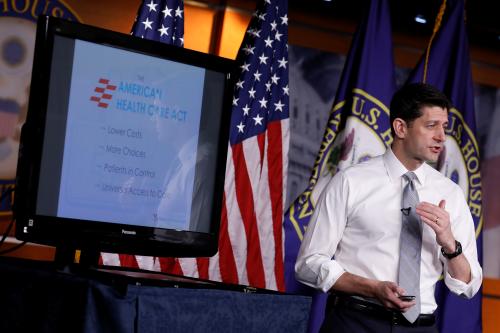In recent weeks, the Trump Administration and House Republicans have been engaged in negotiations aimed at resurrecting the American Health Care Act (AHCA). Last night, the House Rules Committee posted an amendment to the AHCA emerging from those negotiations. The amendment would allow states to waive certain insurance market regulations that exist under current law, including the “community rating” requirements that bar insurers from setting premiums based on health status.
At first glance, it might appear that the community rating waivers allowed under this amendment would only allow insurers to charge premiums based on health status to people with a recent gap in coverage. Even that approach would significantly weaken community rating since coverage gaps are common, including for people with pre-existing conditions. In fact, however, the framework created by the waiver would allow states to effectively eliminate community rating protections for all people seeking individual market coverage, including people who had maintained continuous coverage.
In brief, healthy people would have a strong incentive to “opt out” of the community-rated pool and instead pay a premium based on health status. With healthy enrollees opting out of the community-rated pool, community-rated premiums would need to be extremely high, forcing sicker individuals—including those with continuous coverage—to choose between paying the extremely high community-rated premium or being underwritten themselves. Either way, people with serious health conditions would face prohibitively high premiums. As a result, community rating would be eviscerated—and with it any meaningful guarantee that seriously ill people can access coverage.
The remainder of this blog post describes the amendment and its effects in greater detail.
Description of the Community Rating Waiver Allowed Under the New Amendment
The new amendment, which is sponsored by Representative MacArthur, would allow interested states to waive certain insurance market regulations that exist under current law. Most relevant for this blog post, states would be permitted to partially waive the “community rating” requirements that exist under current law, which forbid insurers from varying premiums based on enrollees’ health status. In particular, insurers would be permitted to vary premiums based on health status for people who “cannot demonstrate” that they had coverage for all but 63 days of the prior twelve months. Health status rating would replace the 30 percent premium surcharge that would otherwise be imposed on people without continuous coverage under the AHCA.
States would technically be required to satisfy certain criteria to receive a waiver, but as noted by Tim Jost, those criteria would be trivial to meet. The state would have to agree to operate a high risk pool, reinsurance program, or related program under other provisions of the AHCA. But that would often happen automatically, and the waiver process would not require the state to ensure that the program is adequately funded (or otherwise effective). Waiver applications would also be required to explain how the waiver would improve the state’s health insurance market along at least one of five dimensions. Those criteria would also be easy to meet. Indeed, one is “reducing average premiums” in the state, which almost any waiver of this type would achieve by driving many sick individuals from the market.
Healthy People Would Opt Out of the Community-Rated Pool, Causing it To Unravel
Implementing a waiver like the one permitted by the MacArthur amendment would have the effect of completely unraveling community rating. Under the waiver, insurers would set two premium schedules: (1) a community-rated premium schedule for people who demonstrate continuous coverage; and (2) a medically underwritten premium schedule for people who do not demonstrate continuous coverage.
Health people would always prefer to pay an underwritten premium since it would allow them to avoid being pooled together with sicker people who have higher health care costs. Indeed, a healthy person opting into the underwritten pool could realize savings of hundreds or thousands of dollars per year. As discussed in detail in the next section, there would likely be no barrier to a healthy person opting to enroll in the underwritten pool. Moreover, it would also be in an insurer’s interest to not only allow prospective healthy enrollees to purchase underwritten policies, but to actively guide enrollees in that direction. If one insurer was unwilling to offer underwritten policies in these cases or failed to make enrollees aware of the option, another insurer could do so and thereby steal the healthy enrollees.
The ultimate outcome would be that premiums in the community-rated pool would have to be set at a prohibitively high level, leaving people with serious illnesses with no affordable options.
As a result, the community-rated pool would attract only people with significant health needs, requiring premiums to be set at a very high level. This would drive still more people into the underwritten pool, driving the community-rated premium still higher. The ultimate outcome would be that premiums in the community-rated pool would have to be set at a prohibitively high level, leaving people with serious illnesses with no affordable options, whether or not they had maintained continuous coverage. Many of these people would likely be driven from the individual market entirely.[1]
Could Healthy People Opt Out of the Underwritten Pool In Practice?
In light of the discussion above, an important question is whether healthy people who maintained continuous coverage would, in fact, be able to opt for the underwritten pool. As the amendment is drafted, they almost certainly would. As noted above, under the amendment, the underwritten premium schedule would apply to anyone who “cannot demonstrate” that they maintained continuous coverage. There is nothing to keep a prospective enrollee from simply declining to provide the needed documentation. For the reasons described above, an insurer would not be motivated to obtain the relevant documentation, so there would be no evident barrier to this strategy.
The federal government could theoretically try to require individuals enrolling in the underwritten pool to prove that they had a coverage gap. It is far from clear that the Trump Administration would actually be interested in doing this, as the administration has reportedly broached allowing state waivers that would fully eliminate community rating in the course of negotiations. But even if the administration were interested in going down this road, it would face an array of practical barriers.
Requiring individuals to affirmatively prove that they lack continuous coverage to enroll in the underwritten pool is not obviously consistent with the statute and would, in any case, be challenging to administer and enforce. Moreover, even if such a documentation requirement could be effectively enforced, it would likely be some combination of ineffective and actively destructive. Healthy people could still access the underwritten pool by dropping coverage for 63 days and then seeking coverage, simultaneously undermining the requirement’s effectiveness and creating unnecessary coverage disruptions. Moreover, people who could not document their continuous coverage status one way or another—including people who had continuous coverage—would be left with literally no way of obtaining individual market coverage. Many other potential enrollees would likely be scared off by the hassle of providing additional documentation, something CBO suggested would occur even under the AHCA’s existing continuous coverage requirement.
How Might States Use These Waivers?
Predicting exactly how many states would take up an option to fully eliminate community rating is challenging, but it is plausible that many states would be interested in such a waiver in light of the fact that only a small minority of states had community rating regulations in place prior to enactment of the Affordable Care Act. This likely reflected the political and economic challenges of implementing community rating without adequate subsidies and an individual mandate, policies that undergird the existing individual market but which the AHCA would weaken or remove entirely. The market disruption caused by the AHCA’s other provisions might also make states receptive to steps they might otherwise decline to consider, particularly steps that lowered some residents’ premiums, even if those premium reductions came at the direct expense of other, vulnerable state residents.
Of course, it is also possible for states to use the waivers allowed by this amendment to weaken community rating in a more contained way. For example, a state could require that the underwritten premiums offered to people without continuous coverage be strictly higher than the community-rated premiums offered to people with continuous coverage. This approach, if strictly enforced, would eliminate the incentive for healthy people to shift into the underwritten pool and thereby keep the community-rated pool from unraveling. It is important to note that, since coverage gaps are common, even this approach would meaningfully weaken the scope of community rating protections and thereby threaten financial security and access to care for people who become seriously ill.
Conclusion
Contrary to appearances, the new MacArthur amendment would, in effect, allow states to completely eliminate community rating. In so doing, the amendment could seriously jeopardize both financial security and access to care for people with serious illnesses. Notably, this is not the only way in which the effects of the MacArthur amendment would be larger than they first appear. For example, the amendment’s provision allowing states to set their own definition of essential health benefits would not only seriously disrupt the individual market, but could also undermine the Affordable Care Act’s ban on annual and lifetime limits and its requirement that plans cap annual out-of-pocket spending for people in employer coverage. In its totality, then, the amendment would almost entirely satisfy House conservatives’ main demand in recent negotiations: eliminating the Affordable Care Act’s major insurance market reforms.
[1] In states that also obtain a waiver of the essential health benefits requirements, sicker individuals might not be driven from the insurance market altogether. Instead, insurers might offer these individuals very stingy coverage (such as coverage with a low annual limit), and these individuals might conclude that coverage was worth taking, particularly in light of the tax credit available under the AHCA. In either case, sicker individuals would be left without access to coverage that provides meaningful financial protection and access to care.









Commentary
New amendment to GOP health bill effectively allows full elimination of community rating, exposing sick to higher premiums
April 27, 2017